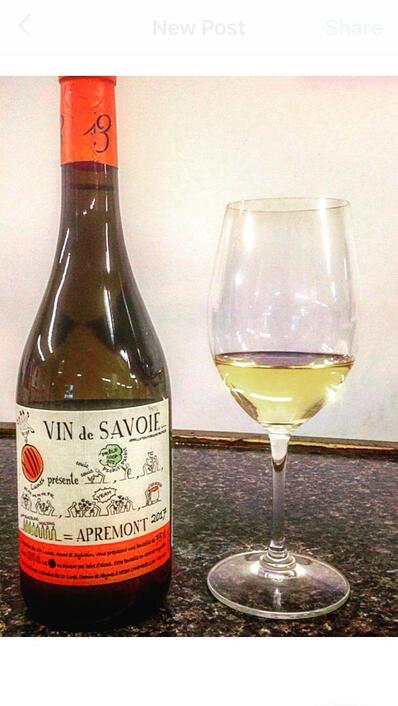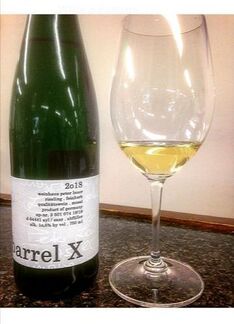 Getting off our little summertime Riesling kick from the last few weeks, but still looking to enjoy a great wine to chill down for hot weather with a bit of obscurity this time. The Savoie region is off the traditional tourist line for French travelers, unless you are looking for spectacular mountain scenery, in which case it's one of the great alpine wine regions of the world. The wines are also becoming more popular with drinkers looking for lower alcohol options. Based along the Swiss border (the closest and most influential major city by a wide margin is Geneva) the region's most important grape by volume is Jacquere, a variety that rarely gets planted anywhere in the world except upon these mountainous vineyard sites. Apremont and Abymes are the two most important sites here, somewhat morbidly named in honor of a terrible landslide off of Mont Granier that buried several villages and thousands of villagers nearly 800 years ago. Apremont (the 'bitter mountain') sits at the higher elevation along the mountain, and this bottling takes advantage of some of the higher parcels to catch precious extra hours of sunlight each season, milking out every last drop of ripeness and intensity that can be found in the delicate Jacquere grape. This 'intensity', of course, is all relative. If you ever heard the word 'crystalline' to describe a wine and wondered what they meant by it, this is the perfect example of that term. Clear light gold in color, the aromas are mostly fresh white fruits with hints of zest and musky melon rind, but all at a very low volume of intensity. The palate is crystalline, and there just isn't any way of getting around that word, with the freshness like mountain stream water punctuated with citrusy acidity that leaves your mouth watering for minutes afterwards. At barely over 10%abv, your first instinct is to think the wine is hiding some residual sugar somewhere. For this grape in this environment it just ripens without much sugar, so this is completely dry and the weight is purely from quality natural ripeness. This is about as refreshing a wine as you can find out there, excellent with a chill to it and ideal with summer salads and cooled seafood dishes.
0 Comments
 Another hot week in Central Virginia, another great dry Riesling for you to throw into the fridge. Anyone want to guess what we love to drink to fight back against the oppressive humidity? With a bit of chill on it, the vibrant acidity cuts through heat like a razor, refreshes your palate without leaving behind anything weighty, and are generally lower in alcohol so you don't feel as guilty going back to top up your glass when it inevitably gets consumed all too quickly. This is also our first offering of what will likely be dozens more from the highly regarded 2018 vintage in Germany, a year being touted not only for the sweeter wines at the top end but the ability it gave for producers to create exactly what they wanted at all price points and levels of dryness. Peter Lauer is one of the great producers of the Saar River, a tiny tributary of the Mosel that rarely gets featured on a label because there are so few that hold vineyards there. He also chooses to make wines that don't follow the traditional German Pradikat labeling laws, so those not in the know may pass over his labels. Most of his wines are intended to 'taste dry' and are allowed to reach whatever residual sugar levels they end at naturally, using native yeasts and only adjusted at the end if needed. Barrel X is a combination of several sites within the Saar, less than a mile apart from each other ('If we were in Burgundy, this would be the equivalent of a Bourgogne Blanc'), and is one of the most ridiculous values you can find that speaks so clearly of its origins. The term Feinherb is used instead of Halbtrocken locally, which means half-dry, referring to the slight amount of residual sugar left here. But if you were honest most people would barely notice it when presented with all the flavor found here. Lychee, lime zest, fresh herbs and tons of white flowers on the nose even with a healthy chill on it out of the fridge, like walking through the produce section of a farmer's market with fruit samples cut open for you to sample. On the palate there is a slight indication of the residual sugar, but the fruit is SO juicy and clean, and the acidity is SO quenching and refreshing it really isn't something anyone should get hung up on. The finish is as long and clean as a bite of a freshly sliced and perfectly ripe lime, with no lingering sweetness at all. This is a wine with immediate pleasure, long life potential, and about as many different reasons to use for enjoyment as there are bottles for you to buy. If you haven't been a bi Riesling fan in the past, now is a good time to start!  Inspired by the Tour de France passing through Alsace yesterday and following the roads of the wine route hard core for most of the afternoon, we pulled out a wine today from one of our favorite Alsatian producers. Domaine Paul Blanck has been a fixture for many generations in the Furstentum Valley, a narrow passage in the Vosges mountains containing four picturesque towns (Kayserberg, Kientzheim, Sigolsheim, and Ammerschwihr) and several highly regarded Grand Cru level vineyards. For those that watched Stage 5 or look for replays online, this is the area before the last two climbs about 35-45 miles from the end of the race, and has some of the prettiest views for the day of the towns and vineyards, in a stage that was positively littered with pretty landscapes. The town of Kayserberg also had a large banner out in their most prominent vineyard, drawing attention to the Schlossburg Grand Cru and the iconic ruins of Chateau du Schlossburg that sits above the walled of the town and the vineyard's edge. The Blanck family was instrumental in Schlossburg getting its Cru status (one of the first in the Alsatian system) and is still one of the larger vineyard owners. All the fruit for their basic level bottlings come from vineyards within the Furstentum Valley, and for varietals like Riesling they do blend some juice from Schlossburg that isn't getting used in their Grand Cru bottlings. So if you want, you can spend 10-15 minutes watching world class cyclists riding past the vines that made the wine you are drinking. When first opened, there is a slight touch of the 'petrol' aroma that comes from many examples of dry Rieslings, especially in Alsace and Germany. A quick decant or a few swirls in the glass will help kick that out to start revealing dried citrus and melon rind aromas as well as a rich wet stone sort of minerality, On the palate there is absolutely no signs of residual sugars, showing lots of vibrant melon and lemon tones, vibrant minerality across the palate and a long lingering stony finish that practically leaves you drooling from the tanginess. Some vintages can carry more honeyed notes and white fruits, so it's important to compare it from year to year when thinking about foods to pair with it. This is a vintage that works with trout and other river fish, savory chicken, and even pork. It can also handle some heat and spices, but wouldn't do it with some of the sweeter glazes or more penetrating heat combinations as you would with wines that have a more noticeable sweet note. |
The Best of the Best.We offering free tastings on these wines in the store every Thursday and Friday, and a 10% discount off the retail price through the duration of the day. Come on by and give them a try! Archives
July 2024
Categories |
Location |
|

 RSS Feed
RSS Feed